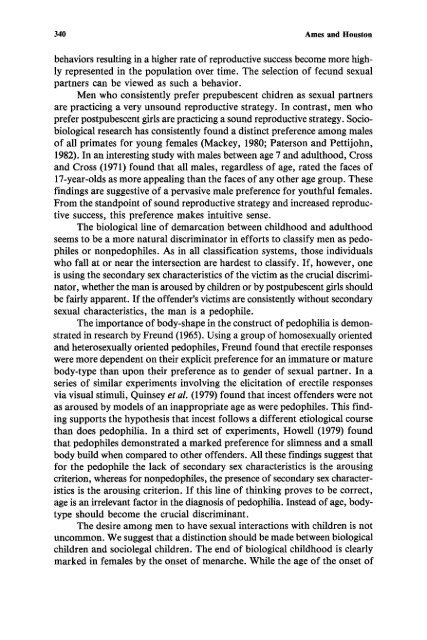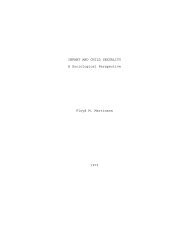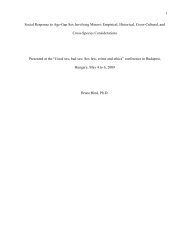Download PDF - Springer
Download PDF - Springer
Download PDF - Springer
Create successful ePaper yourself
Turn your PDF publications into a flip-book with our unique Google optimized e-Paper software.
340 Ames and Houston<br />
behaviors resulting in a higher rate of reproductive success become more highly<br />
represented in the population over time. The selection of fecund sexual<br />
partners can be viewed as such a behavior.<br />
Men who consistently prefer prepubescent chidren as sexual partners<br />
are practicing a very unsound reproductive strategy. In contrast, men who<br />
prefer postpubescent girls are practicing a sound reproductive strategy. Sociobiological<br />
research has consistently found a distinct preference among males<br />
of all primates for young females (Mackey, 1980; Paterson and Pettijohn,<br />
1982). In an interesting study with males between age 7 and adulthood, Cross<br />
and Cross (1971) found that all males, regardless of age, rated the faces of<br />
17-year-olds as more appealing than the faces of any other age group. These<br />
findings are suggestive of a pervasive male preference for youthful females.<br />
From the standpoint of sound reproductive strategy and increased reproductive<br />
success, this preference makes intuitive sense.<br />
The biological line of demarcation between childhood and adulthood<br />
seems to be a more natural discriminator in efforts to classify men as pedophiles<br />
or nonpedophiles. As in all classification systems, those individuals<br />
who fall at or near the intersection are hardest to classify. If, however, one<br />
is using the secondary sex characteristics of the victim as the crucial discriminator,<br />
whether the man is aroused by children or by postpubescent girls should<br />
be fairly apparent. If the offender's victims are consistently without secondary<br />
sexual characteristics, the man is a pedophile.<br />
The importance of body-shape in the construct of pedophilia is demonstrated<br />
in research by Freund (1965). Using a group of homosexually oriented<br />
and heterosexually oriented pedophiles, Freund found that erectile responses<br />
were more dependent on their explicit preference for an immature or mature<br />
body-type than upon their preference as to gender of sexual partner. In a<br />
series of similar experiments involving the elicitation of erectile responses<br />
via visual stimuli, Quinsey et aL (1979) found that incest offenders were not<br />
as aroused by models of an inappropriate age as were pedophiles. This finding<br />
supports the hypothesis that incest follows a different etiological course<br />
than does pedophilia. In a third set of experiments, Howell (1979) found<br />
that pedophiles demonstrated a marked preference for slimness and a small<br />
body build when compared to other offenders. All these findings suggest that<br />
for the pedophile the lack of secondary sex characteristics is the arousing<br />
criterion, whereas for nonpedophiles, the presence of secondary sex characteristics<br />
is the arousing criterion. If this line of thinking proves to be correct,<br />
age is an irrelevant factor in the diagnosis of pedophilia. Instead of age, bodytype<br />
should become the crucial discriminant.<br />
The desire among men to have sexual interactions with children is not<br />
uncommon. We suggest that a distinction should be made between biological<br />
children and sociolegal children. The end of biological childhood is clearly<br />
marked in females by the onset of menarche. While the age of the onset of
















